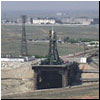|
|
|
|
|
|
Click with the right mouse (PC) or control
click (Mac) to invoke an interactive menu. |
 |
|||||||
|
MULTIMEDIA |
|||||||||
 |
Video
|
||||||||
|
|
Virtual reality
This unique panoramas were stitched out of some dozen images, providing a 360-degree view of the surrounding landscape in Baikonur Cosmodrome: Soyuz facilities: This magnificent view from a hill top in Baikonur in the early hours of April 26, 2001, as sun was rising in the east, right behind Site 1, better known as Gagarin's pad. The Vostok-1 spacecraft with the world's first space traveler was launched from there 40 years earlier. The Soyuz rocket processing facilities could be seen to the south and the Energia-Buran launch complex lay to the northwest.
Energia-Buran facilities: The central region of the Baikonur Cosmodrome occupied by the Energia-Buran facilities.
|
||||||||
Frescos on concrete: Art of Baikonur When driving around Baikonur, a careful observer could notice numerous walls, road signs or simply pieces of concrete touched by a brush of unknown artist. Some artwork still reminded about old ideology, intentionally or unintentionally preserved as in some sort of time capsule, some were brand-new, poeticizing the exploration of space rather then "the party line." |
|||||||||
|
HISTORY |
|||||||||
|
The origin of a test range in Tyuratam In the mid-1950s, the Soviet military had to find a new test site for its secret rocket program. At the time, cruise and ballistic missiles conceived in the country promised to fly not hundreds but thousands of kilometers. Such range would not fit into existing corridors extending from Kapustin Yar on the Volga River to the steppes of Kazakhstan. After considering four most desolate locations it could find, the government commission made a choice, which horrified even war-burned officers at the Soviet Ministry of Defense. The new test range designated NIIP-5 would be built at the Tyuratam junction on the right bank of the Syr Darya River in Kazakhstan. True, no obstacles for the future missiles existed in this barren steppe, but neither did any bare essentials for the life of thousands of workers. |
|||||||||
|
Early years of a test range in Tyuratam The first military construction team, which landed at the Tyuratam junction in January 1955, found a building of the railway station and a village sheltering few dozen people. In the few months, however, this forgotten place was avalanched with trains carrying construction workers, the materials and supplies for the future top-secret test site. Only two years later, after unending struggle with dust and heat in the summer and wind and cold in the winter, capricious soils and infectious diseases, thousands of workers have completed a monumental complex for the R-7 ballistic missile. |
|||||||||
|
In search for the Soviet ICBM test site, the US intelligence employed its most sophisticated weapon of the time -- the U-2 high-altitude spy plane. Unreachable for the Soviet interceptors, the U-2s were flying along major railroads of the Soviet Union trying to pinpoint the new test site. In the summer of 1957, only weeks after the first test flight of the Soviet ICBM, the U-2 mission brought its fruit - the pictures of the R-7 launch pad in Tyuratam. Yet, for decades to come the Soviet government would not confirm the exact location of the test range. |
|||||||||
|
VIRTUAL
GUIDE TO BAIKONUR COSMODROME |
|||||||||
 |
Baikonur Cosmodrome, aka TyNIIP-5 test range, is traditionally subdivided into three regions, which used to be dominated by the launch and processing facilities of the major players in the Soviet rocketry -- Sergei Korolev, Mikhail Yangel and Vladimir Chelomei. These regions are known as "center," "right flank" and "left flank." |
||||||||
|
A virtual tour along the historic road, connecting the town of Baikonur, formerly known as Leninsk, with the launch facilities deep in the steppe. The infamous "motovoz" -- a diesel-powered train shuttling between the town and launch complexes -- has been perhaps the most enduring icon of Baikonur, immortalized in a popular folk song about the center. |
|||||||||
|
Launch complex for the R-7 missile and the Soyuz launcher The very first launch complex founded in 1955 in Tyuratam included a single launch pad at Site 1 and the assembly and processing buildings at Site 2 and 2B. The original R-7 rocket blasted off from Site 1 in May 1957. The world's first artificial satellite was launched from the same pad on October 4, 1957. Following the launch of Vostok-1 in 1961, the Site 1 was nicknamed Gagarin's pad. The complex has remained operational at the turn of the 21st century, after hosting around 400 launches. The second launch pad for R-7-based rockets has been operating at Site 31 since 1960. |
|||||||||
|
|
Launch facilities for R-16 ICBM and Kosmos-1 launcher Around November 1959, the construction of the first launch pads for the R-16 missile started at Site 41. The facility included two surface pads designated PU-3 (Puskovaya Ustanovka) and PU-4. The concrete works started here on December 5, 1959, and according to the construction schedule signed on December 17, 1959, the pads were expected to be ready by September 1960. The first launch attempt took place here in October 1960, however it ended in a worst disaster in the history of rocketry. Site 41 was later restored and the launches of the R-16 ICBM resumed in 1961. One of two pads at Site 41 was later converted into the Voskhod complex for the lightweight Kosmos-1 and Kosmos-3 launchers, which flew from here between 1964 and 1968. |
||||||||
|
Launch facilities for R-9 ICBM In the 1960s, both surface and underground pads were built in Tyuratam for Korolev's R-9 ICBM. The original experimental launch complex for the R-9 ICBM was built just a few hundred meters from the Gagarin's pad. A deadly accident took place in one of the R-9 silos in 1963, exactly three years after the R-16 disaster. |
|||||||||
|
Launch complex for UR-200 ICBM and Tsyklon-2 launcher A two-pad launch complex at Site 90 on the western edge of Baikonur was orginally built to test the UR-200 missile. It flew nine missions from the site in 1963 and 1964, before the program was canceled. By 1967, Site 90 was refurbished for the Tsyklon-2 launcher, delivering anti-satellite weapons and nuclear-powered spy satellites for the Soviet navy. The first launch of the Tsyklon-2 rocket from the site, took place on October 27, 1967. The facility remained operational at the beginning of the 21st century. |
|||||||||
|
Launch facilities for R-36 ICBM The construction of the surface pad for the R-36 (8K67) ICBM was officially approved in June 1962 and the actual construction started in August 1962 at Site 67. Since 1964, the NIIP-5 test range in Tyuratam was responsible for testing of the R-36-O ballistic missiles, whose warheads would reach the orbit on its way to the target. After test launches of orbital rockets from surface and underground launch pads had been completed in 1969, they were operationally deployed in numerous silos around Tyuratam. This most exotic weapon of the Cold War was scrapped in mid-1980s. |
|||||||||
|
Total four launch pads and extensive support infrastructure was built in Tyuratam for the Proton launcher. Baikonur Cosmodrome is the only site from where the Proton can be launched. The original two pads at Site 81 were followed by two additional pads at Site 200. All of them were located on the "left flank" of Baikonur. The entire town, now often called "Proton city," with its own processing and residential area grew up few kilometers southwest from the pads. |
|||||||||
|
Launch facilities for UR-100 ICBM, Strela and Rockot launcher On April 19, 1965, the first compact ICBM UR-100 blasted off from surface pad at Site 130 of the NIIP-5 test range. In the following years multiple silos for the UR-100 and its successors were built on the "left flank" of the test range. Since 1990s, these facilities have been used for test launches of the Rockot booster, which derived from UR-100NU ICBM. |
|||||||||
|
|
Launch facilities for R-36M ICBM A heavy multi-warhead R-36M missile, known in the West as "Satan," succeeded the venerable R-36. During the 1970s and 1980s, the R-36M flew numerous missions from Tyuratam. With the end of the Cold War, the R-36M became a base for the Dnepr launch vehicle, which made three successful launches from a silo complex at Site 109. |
||||||||
|
Launch facilities for the N1 moon rocket and for Energia-Buran Since 1965, the cyclopean launch complex for the N-1 moon rocket was under construction in Tyuratam. In 1969-1972, four ill-fated N-1 boosters blasted off from Tyuratam, resulting in cancellation of the program in 1974. The remaining launch facilities for the N-1 rocket were rebuilt for the new Energia-Buran system with the addition of some monumental infrastructure, including a brand-new processing building, a full-scale test-firing stand, a "skyscraper" for vertical vibration tests and a super-long landing strip for the Buran orbiter. |
|||||||||
|
The Zenit-2 rocket, the Russia's most advanced space booster had two launch pads completed in 1980s at Site 45. One of the pads was practically demolished in the launch failure in 1990. |
|||||||||
|
Town of Baikonur (formerly Leninsk) In Tyuratam, the most ambitious human endeavors coexist with the world, which has not changed for centuries. Originated as a nomadic settlement, in 1901 Tyuratam became a water-pumping station on the railroad linking Moscow with Tashkent. Ironically, Tyuratam means "arrow burial ground" in the local language. Since 1955, the Russian military has erected a whole new town adjacent to the station of Tyuratam. |
|||||||||
|
The NIIP-5 test range is a home of at least four ground control stations used to track launches and communicate with the orbiting spacecraft. They are part of the network of stations run by the Russian military and spread across the former Soviet Union. At the peak of the Cold War, this network also included airborne and sea-based communications posts. |
|||||||||
|
As Baikonur Cosmodrome became the largest space center in the world, hundreds of kilometers of grasslands downrange from the launch site turned into giant shooting gallery, where spent rocket stages would smash into the ground after separating from space rockets or ballistic missiles. Dozens of impact sites occupied millions of acres of land. |
|||||||||
|
|